January 19, 2022
Every year in January, thousands of research sessions take place within the walls of the Walter E. Washington Convention Center as transportation professionals from all disciplines and locations gather to identify research needs and share new findings that will inform future projects. The 2022 Transportation Research Board (TRB) Annual Meeting took place January 9-13, and as always, inspired ideas and conversation that will continue well past the five-day conference-but this year also brought many differences from TRBs past. Read on for a summary of the event and the themes that stuck out to us as the transportation profession enters 2022.
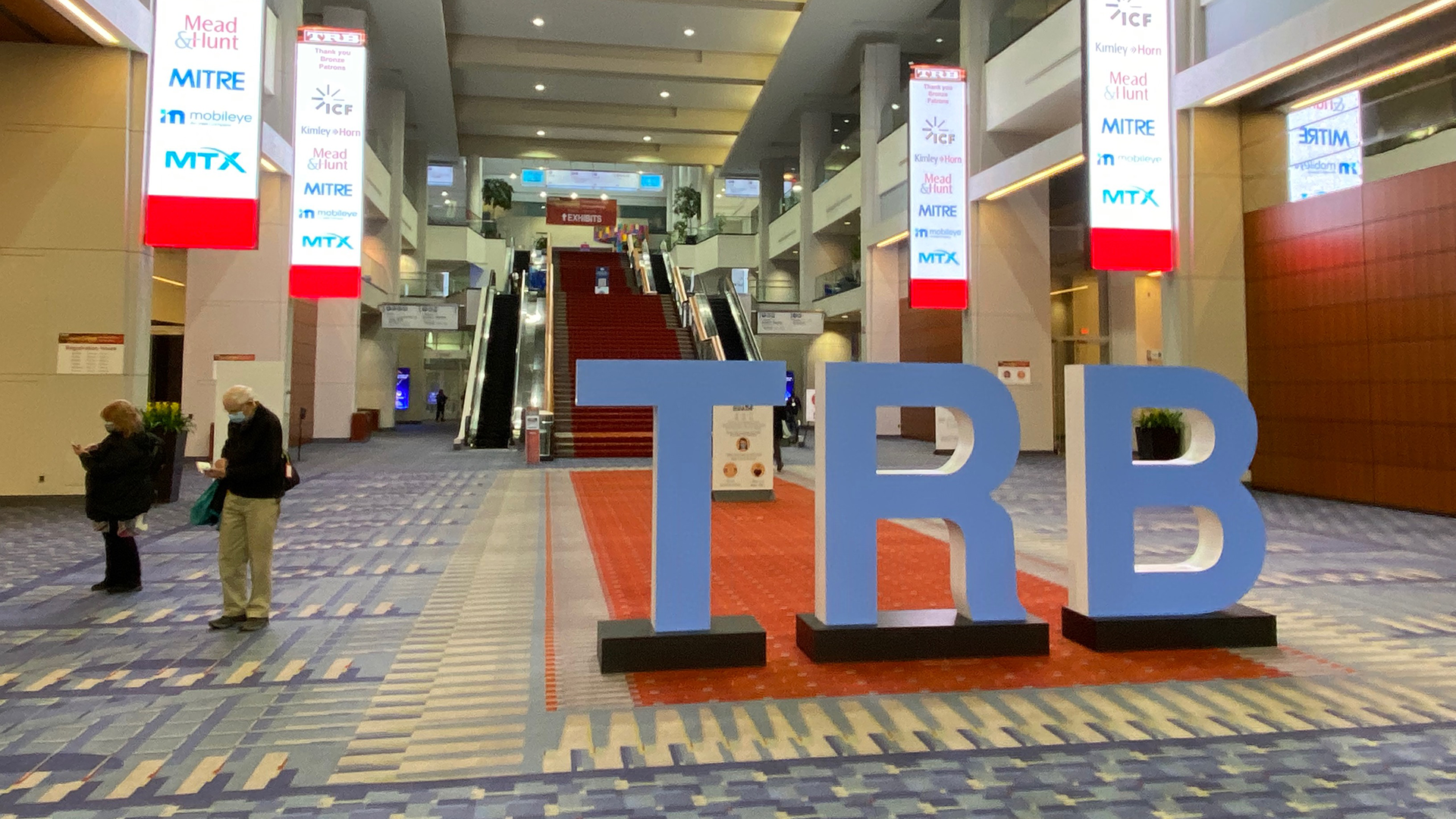
The 2022 TRB Annual Meeting
While it was a return to its traditional in-person format, TRB’s 101st Annual Meeting was anything but typical. Registrants were faced with tough decisions about attending in the midst of pandemic concerns, weather events, and flight cancellations, with many (including some of our own staff) making the call to stay home.
Through all of the uncertainty, however, we were encouraged by the “coming together” of the transportation research community, with a heightened focus on sharing information with those unable to attend in person. Some sessions configured virtual setups, others delayed important discussions for when more people could be there, and those who did attend found creative ways to share what they were learning with colleagues checking in from home. TRB took added steps to make the event as safe as possible, with vaccination and mask requirements in place, space for distancing during sessions, and frequent room cleanings.
“It was quieter and more subdued than your normally chaotic TRB,” said Senior Principal Engineer Nagui Rouphail. “The poster sessions were different in that many of our overseas presenters did not make it and poster boards were empty. The committee meetings, however, were well attended, and generated good discussion.”
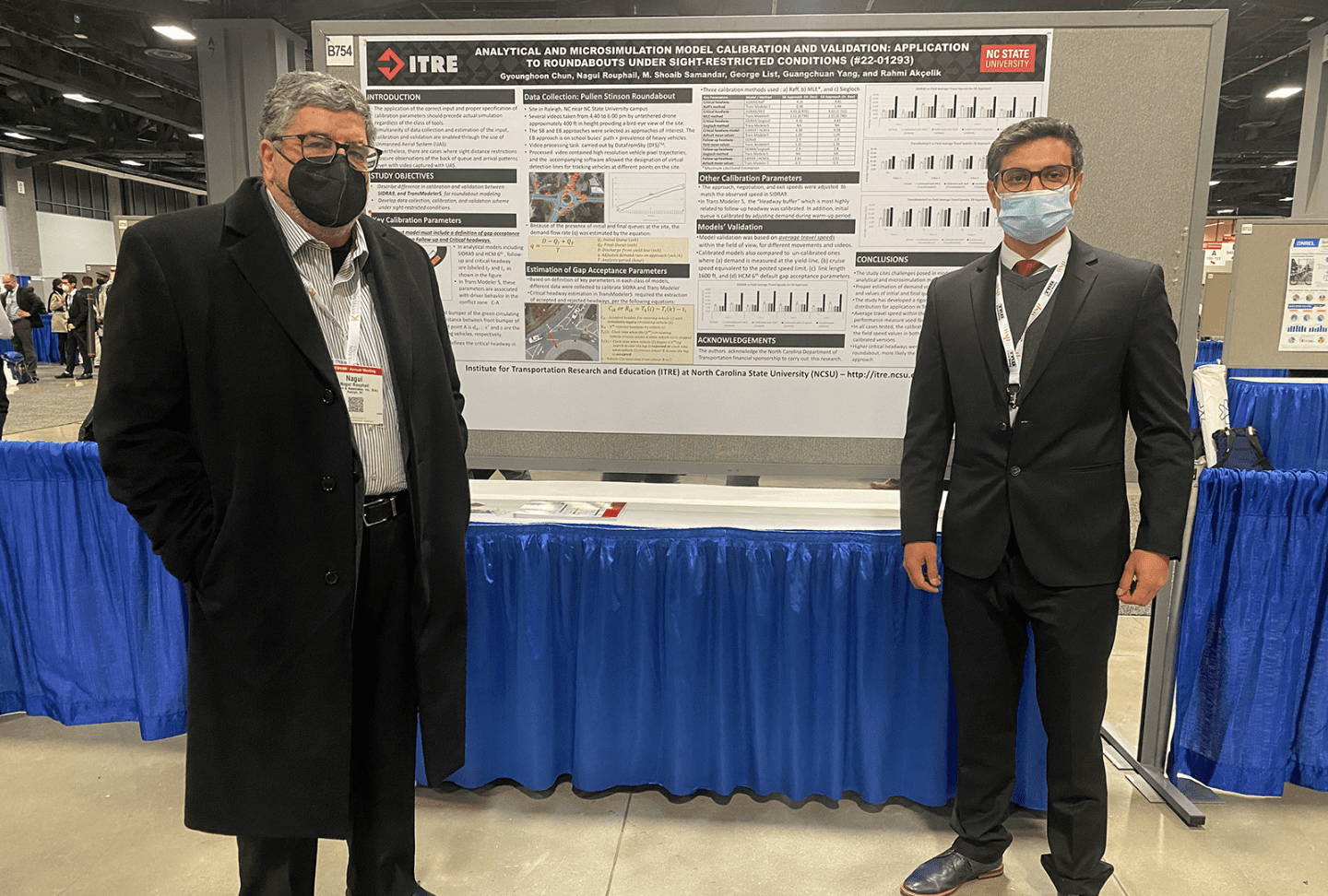
Nagui Rouphail and his co-author from NCSU pose with their poster.
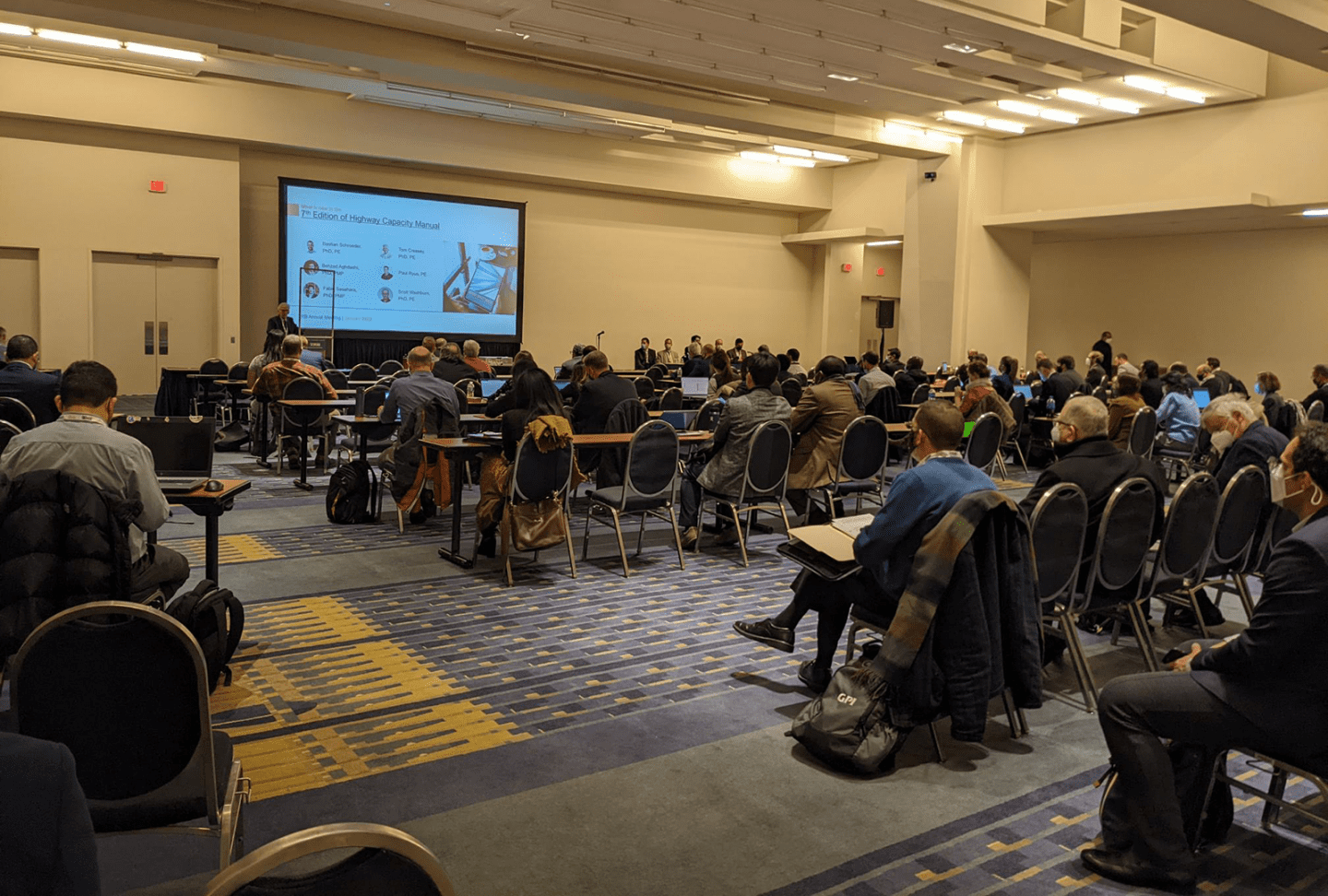
Highway Capacity and Quality of Service Committee Meeting, which covered highlights of the HCM7.
6 Themes From TRB 2022
Speaking of sharing what we learned-given the whirlwind of information that is always present at such a massive conference, we like to conclude our TRB attendance by posting the themes that stood out to our staff. If you were unable to attend, we hope you find this summary useful; if you were at TRB, we’d love to hear if you agree and what other themes struck you!
Welcoming Voices from Outside Traditional Transportation Fields
“At TRB 2021, we talked about recognizing and breaking down silos in transportation,” said Senior Planner Meredyth Sanders. “TRB’s committees and members took a step towards this at TRB 2022 in some exciting ways.”
The Bicycle Transportation Committee dedicated time in their committee meeting to a panel discussion on Increasing Equity in Bicycling, featuring representatives from academia (Dr. Jesus Barajas, UC Davis), consulting (Dr. Stefanie Brodie, Toole Design), and advocacy (Oboi Reed, Equiticity). The panelists provided perspectives on making bicycling research more relevant to advocates and practitioners and breaking down barriers to participation in TRB-related work. Recommendations raised by the panel included:
- Explore whether bicycling projects result in more positive outcomes if they serve a social as well as functional purpose
- Apply quantitative research results in the context of qualitative research (i.e., listening to communities to understand their different needs)
- Make research translatable and accessible to people with diverse backgrounds
Committee Chair Rebecca Sanders shared real-time panel insights via Twitter.
Infrastructure Investment and Jobs Act
As predicted, the Infrastructure Investment and Jobs Act made its way into discussions all across TRB and sparked discussion about the opportunities ahead in our profession, as well as the role of transportation professionals in making sure all communities can access those opportunities. Discussions focused on how the funding will be translated into transportation projects that cover a variety of modes and serve communities of all types. USDOT Secretary Pete Buttigieg spoke about this during the Chair’s Plenary session, noting they are working to make sure funding from the Infrastructure Investment and Jobs Act is accessible to large cities and small municipalities alike.
“We need to make sure it is a user-friendly process and one that is as accessible to a small community that may not have a full-time federal relations person on staff as it is for our biggest cites,” said Secretary Buttigieg. “It is very important to make sure that every kind of community feels the impact.”
Equity
Hand in hand with the discussion on opportunity was a focus on equity, as our profession seeks to learn from history in approaching future transportation investments. Conversation ranged from the equity impacts of congestion pricing, to the role of transportation projects in housing costs and gentrification, to serving vulnerable populations, such as seniors, during a global pandemic.
“I attended one lecture session that was devoted to going beyond Title VI and thinking about how transit agencies collect demographic data,” said Planner Esteban Doyle. “The type of data we use and at what scale can have meaningful impacts to our understanding of who is being served by transit. The demographics along a corridor can look very different from the demographics at a specific transit stop location. There was emphasis on the need for more information on transit riders and how transit agencies can utilize ridership surveys and cell phone data more.”
The theme of equity came through strongly in several insightful panel discussions. Panelists at the Bicycle Transportation Committee meeting noted the need to shift power and resources to the people experiencing problems at the local level. They are best suited to deliver equitable solutions. At the State DOT roundtable, speakers also emphasized the need to partner with local communities, as well as hire more diverse staff internally. Toks Omishakin (Caltrans) made an important point that if we are ever going to succeed at creating a more equitable transportation system, we must move from the symbolic to the systemic.
Breaking Down Barriers to TRB Participation
2022 shone a light on the important conversation of breaking down barriers to participating at TRB. In order to make space for new perspectives, we must help new attendees onboard and navigate the “black box” that transportation research and TRB can feel like. Especially in a year like this one, when more barriers than ever existed for both new and returning attendees, there was an acknowledged responsibility on those of us who attended to spread what we learned.
“I reflected on my drive home about how those of us who had the opportunity to attend TRB-because we have stable child care, robust immune systems, flexible employers, and the ability to avoid contact with high-risk family members or roommates for a few days after returning-can share what we’ve learned with those who are more impacted by this latest COVID surge,” said Senior Engineer Shannon Warchol.
Collaboration With State and Federal Agencies
Another major takeaway from our team was how important it is for TRB committees to collaborate with state and federal agencies to identify research needs, beginning with relationship building.
“At the Performance Effects of Geometric Design committee meetings, we reflected on how critical it is to engage AASHTO early and frequently within the cycle of developing research needs statements so that they are included and ultimately supported through the funding process,” said Senior Engineer Zachary Bugg. “While the remote work environment has made this even more challenging, we identified several steps toward reestablishing and building relationships with these peers in our profession to support our shared goals.”
What We Do With Research Findings
Finally, as complex and data-intensive as our transportation research is today, we need to continue to emphasize the practical application of our findings for practitioners.
“Research is not an end in itself,” said Principal Engineer Ryan Cunningham. “It’s much bigger than that. In order to meet its useful end, it must eventually connect to practical application.”
This was emphasized in reference to planning, operations, and safety guidance for practitioners (such as the Highway Capacity Manual and Highway Safety Manual), as well as from a community engagement and equity perspective. Research needs to be translatable and accessible to advocates and stakeholders, and those most affected.
What Stood Out To You?
There were far more important discussions than we could capture here, so we’d love to hear your primary takeaways from TRB 2022. Share them with us on LinkedIn!
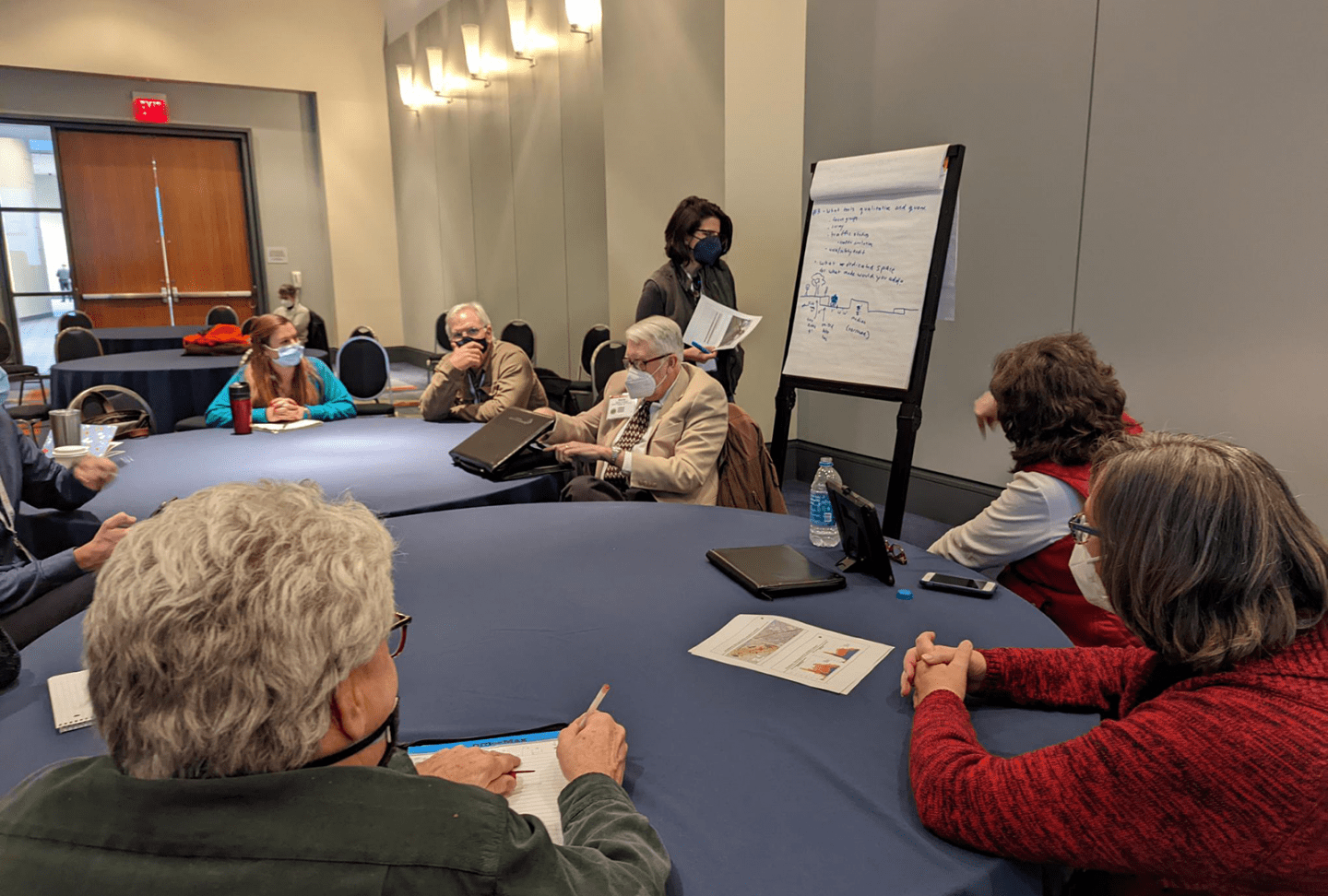
Participants at the Safety and Livability Workshop discuss tradeoffs of possible roadway cross section reallocations.
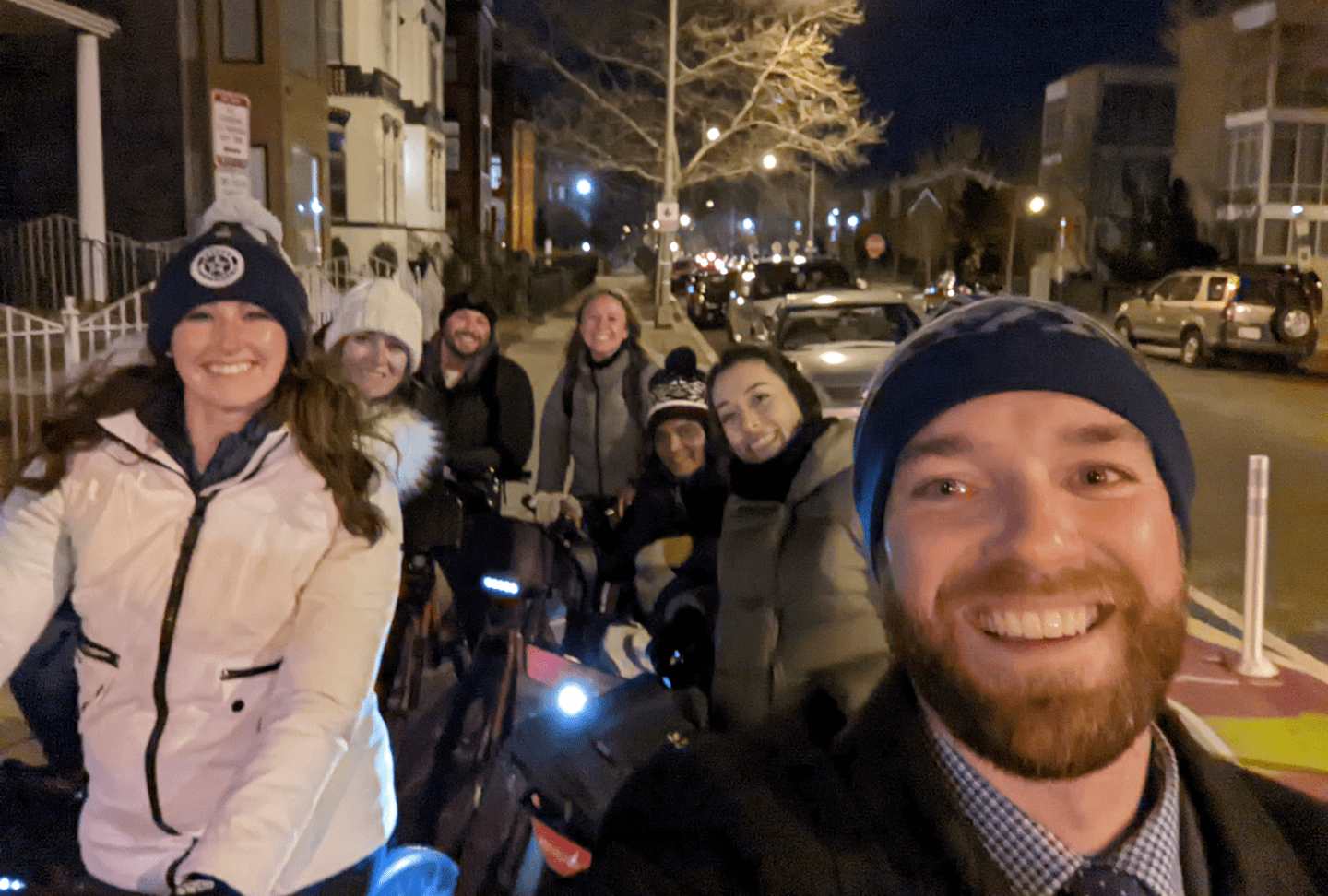
What do we do after a full day of TRB sessions? Explore DC's bike facilities, of course!
